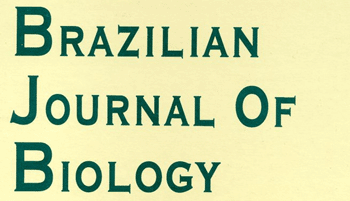Resumo em Português:
Resumo A espécie de bagre Sciades proops habita principalmente estuários de águas rasas enlameada e lagoas salobras, ocorrendo também em águas doces. Por esses motivos acredita-se que essa espécie pode atuar como hospedeiro intermediário, definitivo e paratênico no ciclo de vida de vários parasitas. Entre novembro de 2010 a novembro de 2011 e de agosto de 2012 a julho de 2013, Um total de 126 espécimes de Sciades proops originários da região estuarina do rio Japaratuba, município de Pirambu, SE, foram examinados em busca de parasitas, dos quais 84,13% estavam parasitados por pelo menos uma espécie de parasita encontrada: Ergasilus sp. (Copepoda) (Prevalência (P)=77,78%; Intensidade Média (IM) =10,08±15,48, AbundÂncia Média (AM) =7,48±14,27) nas brânquias, Contracaecum sp. (P=23,02%; IM=20,59±80,58, AM=4,47±39,12) na cavidade geral, Procamallanus sp. (P=0,79%; IM=1, AM=0,01±0,09), Raphidascaroides sp. (P=2,31%; IM=1,33±0,58, AM=0,33±0,22) e Cuccullanus sp. (P=0,79%; IM=1, AM=0,01±0,09) (Nematoda) no intestino, Ancyrocephalinae (Monogenea) (P=0,79%; IM=1, AM=0,01±0,09) nas brânquias, Pseudoacanthostomumpanamense (P=1,59%; IM=9,00±8,49, AM=0,14±1,36) no intestino, Clinostomum sp. (P=1,59%; IM=17,50±23,33, AM=0,29±3,03) na superfície do corpo e duas metacercárias não identificadas, denominadas como Metacercária 1 (P=0,79%; IM=1, AM=0,01±0,09) e Metacercária 2 (P=0,79%; IM=7, AM=0,06±0,62) (Digenea) ambas na bexiga natatória. Ergasilus sp. foi a espécie dominante sendo classificada como central, Contracaecum sp. como a satélite e as demais como espécies secundárias. A distribuição espacial da infecção por Ergasilus sp. e Contracaecum sp. apresentaram um padrão típico de distribuição agregada. O sexo dos hospedeiros não influenciou nas infecções parasitárias, porém a infecção por Ergasilus sp. apresentou correlação positiva e significativa entre os parâmetros biométricos e os parâmetros epidemiológicos enquanto que na infecção por Contracaecum sp. a correlação ocorreu apenas com a prevalência e a abundância.
Resumo em Inglês:
Abstract The catfish species Sciades proops inhabits muddy estuaries and shallow brackish lagoons, as well as freshwater. For these reasons, it is believed that this species may act as an intermediate, definitive and paratenic host in the life cycle of many parasites. From November 2010 to November 2011 and from August 2012 to July 2013, a total of 126 specimens of Sciades proops from the estuarine region of the Japaratuba River in the state of Sergipe, Brazil, were examined for parasites, of which 84.13% were infected by at least one species: Ergasilus sp. (Copepoda) (Prevalence P = 77.78%, Mean of Intensity MI = 10.08 ± 15.48, Mean Abundance MA = 14.27 ± 7.48) in the gills, Contracaecum sp. (P = 23.02%, MI = 20.59 ± 80.58, MA =39.12 ± 4.47) in the general cavity, Procamallanus sp. (P = 0.79%, MI = 1, MA = 0.01 ± 0.09), Raphidascaroides sp. (P = 2.31%, MI = 1.33 ± 0.58, MA = 0.33 ± 0.22) and Cuccullanus sp. (Nematoda) (P = 0.79%, MI = 1, MA = 0.01 ± 0.09) in the intestine, Ancyrocephalinae (Monogenea) (P = 0.79%, MI = 1, MA = 0.01 ± 0.09) in the gills, Pseudoacanthostomumpanamense (P = 1.59%, MI = 9.00 ± 8.49, MA = 0.14 ± 1.36) in the intestine, Clinostomum sp. (P = 1.59%, MI = 17.50 ± 23.33, MA = 0.29 ± 3.03) on the body surface and two unidentified metacercariae, referred to as Metacercaria 1 (P = 0.79%; IM = 1, MA = 0.01 ± 0.09) and Metacercaria 2 (Digenea) (P = 0.79%, MI = 7, MA = 0.06 ± 0.62) in the swim bladder. Ergasilus sp. was the dominant species and thus classified as core, with Contracaecum sp. as the satellite and other species as secondary species. The spatial distribution of infection with Ergasilus sp. and Contracaecum sp. showed a typical pattern of aggregate distribution. The sex of the host did not influence parasitic infections, but infection with Ergasilus sp. showed a positive and significant correlation with biometric and epidemiologic parameters, whereas infection with Contracaecum sp. was correlated only with prevalence and abundance.
